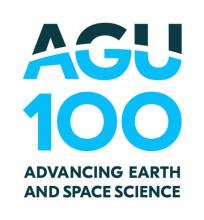| Monday |
|
December 10, 2018 |
|
|
| 08:00-12:20 |
Convention Ctr–Hall A-C (Poster Hall) |
SH11C-2880: Ionospheric Effects of the August 2017 Eclipse: Empirically Guided Modeling with Comparisons to Data |
Magda Moses, KM4EGE (Virginia Tech) |
Solar Eclipse Effects |
| 08:00-10:00 |
Marquis - Marquis 1-2 |
ED11B: STEM Education and Outreach: Building Effective Research Collaboration Models I |
Laura Lukes, KK4FYT (George Mason) |
|
| 08:30-08:45 |
Convention Ctr–206 |
SH11B-03: EclipseMob 2020/2024 Bluetooth-Based Kit for Crowdsourced Ionospheric Measurements |
Laura Lukes, KK4FYT (George Mason) |
Solar Eclipse Effects |
| 08:45 - 09:00 |
Convention Center - 206 |
SH11B-04: Wave Motions in the Ionosphere Associated with the August 2017 Solar Eclipse |
Terry Bullett, N0ASP (U of Colorado) |
Solar Eclipse Effects |
| 09:07-09:22 |
Convention Ctr–202B |
SA11A-05: Concurrent Solar Flare and Geomagnetic Storm Effects on the Thermosphere and Ionosphere During September 2017 |
Liying Qian (NCAR/UCAR) |
Solar Flares and Storm Effects |
| 11:24-11:38 |
Convention Ctr–202B |
SA12A-05: Causes and Effects of Small-Scale Plasma Density Irregularities in the Mid-Latitude Ionosphere |
J. Michael Ruohoniemi (Virginia Tech) |
Small-Scale Mid Latitude Irregularities |
| 12:06-12:20 |
Convention Ctr–202B |
SA12A-08: High Frequency Communications Response to Solar Activity of September 2017 as Observed by Amateur Radio Networks |
Nathaniel Frissell, W2NAF (NJIT) |
Solar Flares and Storm Effects |
| 13:40-18:00 |
Convention Ctr–Hall A-C (Poster Hall) |
SM13B-2858: Comparison of Diffusion Region Proxy Parameters in the Geomagnetic Tail |
Anthony Rogers, AD0EN (UNH) |
|
| 13:40-18:00 |
Convention Ctr–Hall A-C (Poster Hall) |
SA13C-2786: Citizen Space Science: A Preliminary Systematic Study of HF Radio Propagation from a Source in the Subarctic Using HAARP and the Ham WSPR Network |
Christopher Fallen, KL3WX (UAF) |
|
| Tuesday |
|
December 11, 2018 |
|
|
| 08:00-12:20 |
Convention Ctr–Hall A-C (Poster Hall) |
SA21A-3145: Ionospheric sounding using signal of opportunity |
Alex Cushley, VA3CUS (Royal Military College of Canada) |
|
| 08:00-12:20 |
Convention Ctr–Hall A-C (Poster Hall) |
SA21A-3165: New Daytime Thermosphere ionosphere observations during the HIWIND Flight in 2018 |
Qian Wu (NCAR) |
|
| 08:00-12:20 |
Convention Ctr–Hall A-C (Poster Hall) |
SA21A-3167: In Sutu Ion Density and Composition Measurements with the Radio Receiver Instrument on e-POP Using Excitation of Plasma Waves by Photo Electrons |
Paul Bernhardt, KF4FOR (NRL) |
|
| 10:32-10:44 |
Marriott Marquis - Marquis 1-2 |
PA22B-02: Modeling Amateur Radio Soundings of the Ionospheric Response to the 2017 Great American Eclipse (Invited) |
Nathaniel Frissell, W2NAF (NJIT) |
Solar Eclipse Effects |
| 12:05-12:20 |
Convention Ctr–207B |
SH22B-08: Current and Future Community Integrative Science and Discovery Using Incoherent Scatter Radar Techniques (Invited) |
Phil Erickson, W1PJE (MIT Haystack) |
|
| 13:40-18:00 |
Convention Ctr–Hall A-C (Poster Hall) |
SA23A-3178: Electron-electron collision effects on ISR temperature measurements |
William Longley (Boston University) |
|
| 13:40-18:00 |
Convention Ctr–Hall A-C (Poster Hall) |
SA23A-3181: HF Propagation Experiments Through Ionospheric Heated Regions Using e-POP |
Stanley Briczinski (NRL) |
|
| Wednesday |
|
December 12, 2018 |
|
|
| 13:40-18:00 |
Convention Ctr–Hall A-C (Poster Hall) |
SA33C-3501: Horizontal and Vertical Structures of Large- Scale Traveling Ionospheric Disturbances Observed with GNSS Receivers and Millstone Hill Incoherent Scatter Radar |
Shunrong Zhang (MIT Haystack) |
TIDs |
| 13:40-18:00 |
Convention Ctr–Hall A-C (Poster Hall) |
SA33C-3491: Observations of Traveling Ionospheric Disturbances at Midlatitudes during Geomagnetic Storm of 1–3 September 2016 |
Sergii Panasenko (Institute of the Ionosphere) |
TIDs |
| 13:40-18:00 |
Convention Ctr–Hall A-C (Poster Hall) |
SA33B-3470: Ionospheric Disturbances During the September 2017 Geomagnetic Storm |
Anastasia Newheart (Rice) |
Solar Flares and Storm Effects |
| 13:40-18:00 |
Convention Ctr–Hall A-C (Poster Hall) |
SA33C-3504 Millstone Hill incoherent scatter radar fine-scale observations of traveling ionospheric disturbances using Langmuir mode techniques |
Lilias Gasque (Dartmouth) |
TIDs |
| 13:40-18:00 |
Convention Ctr–Hall A-C (Poster Hall) |
SM33C-3586: Characteristics and Effects of Strong Subpacket Structure near 1/4 fce in VLF Chorus Risers |
John Foster (MIT Haystack) |
|
| 13:40-18:00 |
Convention Ctr–Hall A-C (Poster Hall) |
SA33C-3500 Inter-Hemispheric Coupling of Large Scale Travelling Ionospheric Disturbances During Geomagnetic Storms |
Olusegun Jonah (MIT Haystack) |
TIDs |
| 13:40-18:00 |
Convention Ctr–Hall A-C (Poster Hall) |
SA33B-3479: Advances and Features of Meteor Radar Techniques for M-L-T Region Neutral Wind Characterization |
Phil Erickson, W1PJE (MIT Haystack) |
|
| Thursday |
|
December 13, 2018 |
|
|
| Friday |
|
December 14, 2018 |
|
|
| 08:00-12:20 |
Convention Ctr–Hall A-C (Poster Hall) |
ED51F: Citizen Science Showcase: Strategies to Engage Citizens and Students in Research I Posters |
Bill Liles, NQ6Z |
|
| 16:00-18:00 |
Marriott Marquis - Marquis 7-8 |
ED54A: Citizen Science Showcase: Strategies to Engage Citizens and Students in Research II |
Bill Liles, NQ6Z |
|

